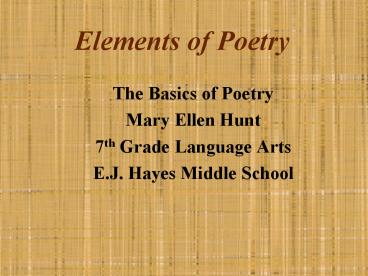Elements of Poetry - PowerPoint PPT Presentation
1 / 8
Title:
Elements of Poetry
Description:
Onomatopoeia the use of words that sound like what they mean. Ex. Fizz, crash, buzz ... Concrete poems have a shape that suggests their subject. ... – PowerPoint PPT presentation
Number of Views:279
Avg rating:3.0/5.0
Title: Elements of Poetry
1
Elements of Poetry
- The Basics of Poetry
- Mary Ellen Hunt
- 7th Grade Language Arts
- E.J. Hayes Middle School
2
Poetry is.
- A group of words arranged on a page that
expresses a thought, emotion, image or insight
using targeted, musical, and emotional word
choices
3
Speaker
- When an author writes a poem, he or she uses an
imaginary voice that narrates the poem. This
voice can be the actual voice of the author, or
it can be the author taking on the persona of
something or someone else. This is known as the
speaker of the poem.
4
Sound Devices
- A sound device is a technique that an author uses
to make the poem sound musical when read aloud. - Rhymethe repetition of sounds at the end of
words. - Rhyme schemea regular pattern of rhyming words
in a poem. - Rhythmthe pattern of stressed and unstressed
syllables in a poem. - Repetitionthe use, more than once, of any
element of language - Refraina regularly repeated line or group of
lines in a poem.
5
Sound Devices, part two
- Alliterationthe repetition of the initial
consonant sound. Ex. Leaping lizards left
Laredo. - Assonancethe repetition of vowel sounds. Ex.
Echoes of woes surround the ode. - Consonancethe repetition of consonant sounds in
the middle or ends of words. Ex. Sibilance, the
snakes excellent essay. - Onomatopoeiathe use of words that sound like
what they mean. Ex. Fizz, crash, buzz
6
Figurative Language
- Metaphora direct comparison between two unlike
things. - For example, I can say, This class is a zoo.
- Simile an indirect comparison between two unlike
things using like or as. - Allusiona reference to a well-known person,
event, place, literary work, or work of art. - Dictionthe way an author chooses particular
words and puts them together. - Sensory Language (Imagery)words/images that
appeal to the readers five senses.
7
Figurative Language, part two
- Oxymoronputs two opposing or contradictory
images together for effect e.g. jumbo shrimp. - Personificationwhen an author gives something
non human (usually, an animal) human personality. - Symbolismthe use of symbols (objects that stand
for something else) in poetry. - Hyperbolethe use of exaggeration to emphasize a
point e.g. Im so hungry I could eat 1,000
hamburgers.
8
Poetic Forms
- Concrete poems have a shape that suggests their
subject. - Free verse poems are not written in a regular
rhythm or meter. - Haiku are 3 line poems that are arranged in a
5-7-5 syllable format and are usually about
nature. - Limericks are humorous, rhyming, five line poems
with a specific meter and rhyme scheme. - Lyric poems are highly musical and express the
observations and feelings of a single speaker. - Narrative poems are stories told in verse.































